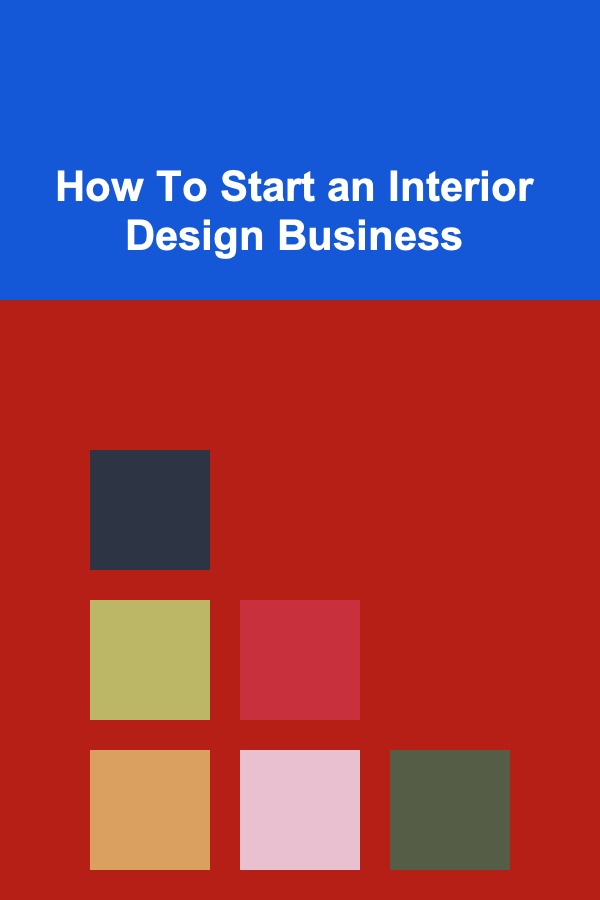
How To Start an Interior Design Business
ebook include PDF & Audio bundle (Micro Guide)
$12.99$6.99
Limited Time Offer! Order within the next:

Starting an interior design business is an exciting journey that allows you to blend creativity with entrepreneurship. As an interior designer, you not only help clients transform their spaces but also build a business that can grow and thrive in a competitive industry. Whether you're a seasoned designer or just starting out, launching your own interior design business can be highly rewarding. In this article, we will explore everything you need to know about starting an interior design business, from the initial steps to growing your brand and clientele.
Understand the Industry
Before diving into your business, it's crucial to have a strong understanding of the interior design industry. The interior design sector is vast and constantly evolving. It includes a range of services such as residential, commercial, hospitality, and more. Understanding market trends, your target audience, and the competition in your area will give you a clear vision of where your business fits in the larger industry landscape.
Key Factors to Consider:
- Market Demand: There is growing demand for interior design services, driven by trends in homeownership, renovations, and commercial developments. A survey by the U.S. Bureau of Labor Statistics shows a steady demand for interior designers, especially those with specialized skills.
- Specialization: Interior designers often specialize in different niches, such as eco-friendly design, modern or classic styles, commercial spaces, or residential design. Deciding on your niche can set you apart from the competition and appeal to specific client needs.
- Technology and Trends: The rise of smart homes, sustainability concerns, and virtual design tools have all impacted the interior design industry. Understanding these trends will keep you relevant and allow you to provide modern solutions to clients.
Develop Your Skills and Credentials
While having a creative eye is essential, interior design also requires technical skills, knowledge of building codes, and a solid understanding of architecture. Developing these skills and earning the necessary credentials is essential for long-term success in the field.
Education and Training
To run a legitimate and successful interior design business, obtaining formal education in interior design is a significant step. Many accredited schools and universities offer undergraduate and postgraduate programs in interior design, which can help you acquire the necessary knowledge and skills.
- Degree: While a degree in interior design is not always a requirement, it provides a strong foundation in design principles, color theory, space planning, and technical skills such as CAD (Computer-Aided Design).
- Certifications: Depending on your location, certification may be required to practice as an interior designer. For instance, the National Council for Interior Design Qualification (NCIDQ) certification is recognized in the U.S. and Canada. Certification demonstrates a high level of competency and credibility in the industry.
- Ongoing Learning: As trends and technologies evolve, it's crucial to stay updated. Attend workshops, online courses, and trade shows to refine your skills and stay ahead of the competition.
Practical Experience
Hands-on experience is invaluable. Whether through internships, apprenticeships, or freelance work, practical experience allows you to understand real-world challenges, client needs, and design solutions. Consider working under an experienced interior designer to learn the ropes before branching out on your own.
Create a Business Plan
Every successful business begins with a solid business plan. A business plan outlines your vision, strategy, and goals for your interior design business. It serves as a roadmap, helping you stay focused and organized while providing a detailed framework for growth and expansion.
Key Elements of a Business Plan:
- Executive Summary: A brief description of your business, including the services you will offer, your target market, and your mission.
- Market Research: An analysis of the interior design market in your area, including competition, target demographics, and market trends. Identify what makes your business unique and why customers would choose you over others.
- Services Offered: Define the types of interior design services you will provide. Will you focus on residential projects, corporate spaces, or hospitality design? Be specific about the services you will offer, including design consultation, project management, furniture sourcing, etc.
- Pricing Strategy: Determine your pricing model, whether it's hourly rates, flat fees, or per-project pricing. It's essential to conduct market research to understand the going rates in your area and ensure your pricing is competitive yet sustainable.
- Marketing Strategy: Outline how you plan to promote your business. This may include a combination of digital marketing (website, social media, SEO), networking, and word-of-mouth referrals.
- Financial Projections: Provide realistic financial projections, including start-up costs, operating expenses, and expected income. It's crucial to have a clear picture of the financial health of your business and any funding you may need to get started.
Legal Requirements and Business Structure
Once you have your business plan in place, it's time to make the business official. You'll need to choose a legal structure, register your business, and obtain any necessary licenses or permits.
Choosing a Business Structure:
There are several business structures you can choose from, each with its advantages and disadvantages:
- Sole Proprietorship: This is the simplest structure, where you operate the business as an individual. You'll be personally liable for any debts or liabilities, so it's best for small-scale operations.
- Limited Liability Company (LLC): An LLC separates your personal and business assets, offering protection from personal liability while providing tax benefits.
- Corporation: A corporation is a separate legal entity that offers the most protection from personal liability but comes with more complex tax and legal requirements.
Business Licensing:
Depending on your location, you may need to apply for a business license, zoning permits, or other regulatory approvals. Check with your local business licensing office to ensure you're compliant with all requirements.
Insurance:
It's crucial to have the right insurance coverage for your interior design business. Common types of insurance include:
- Professional Liability Insurance: Protects against lawsuits for design mistakes or negligence.
- General Liability Insurance: Covers property damage or injuries that occur while working on a project.
- Workers' Compensation Insurance: Required if you have employees.
Build Your Brand and Portfolio
Branding plays a significant role in differentiating your interior design business from competitors. A strong, cohesive brand that reflects your design philosophy will attract clients who resonate with your style and approach.
Develop a Strong Visual Identity:
- Logo and Branding: A professional logo and consistent branding materials (business cards, stationery, etc.) are essential for establishing your identity in the market.
- Website: Your website is often the first point of contact with potential clients, so it must be visually appealing, easy to navigate, and showcase your best work. Include a portfolio of completed projects, client testimonials, and a blog to demonstrate your expertise.
- Social Media Presence: Platforms like Instagram, Pinterest, and Houzz are invaluable for showcasing your work and connecting with potential clients. Use these platforms to post before-and-after photos, design tips, and industry news to engage with your audience.
- Networking: Build relationships with other professionals in the industry, such as architects, contractors, and real estate agents. These connections can lead to referrals and collaborations that benefit your business.
Build a Portfolio:
A strong portfolio is one of your most important marketing tools. Even if you're just starting out, consider offering discounted services or doing pro bono work for friends or family in exchange for permission to use the completed projects in your portfolio.
Pricing and Managing Projects
Setting your prices can be challenging but is essential for ensuring the profitability of your business. You'll need to find the right balance between being competitive in the market and covering your expenses.
Pricing Strategies:
- Hourly Rates: Charge by the hour for your design services. This method works best for consultation-based work or when the scope of the project is unclear.
- Flat Fees: Set a flat fee for specific projects. This is ideal for straightforward design projects with a clear scope of work.
- Percentage of the Project Budget: Charge a percentage of the total project cost. This method works well for larger projects, especially in residential or commercial design.
- Retainers: For ongoing services, you may offer a retainer fee. This ensures you're compensated for the time and resources spent on a client's project.
Project Management:
Effective project management is crucial for delivering projects on time and within budget. Establish clear timelines and budgets with clients upfront, and regularly communicate with them throughout the process.
Market Your Business
Once your business is up and running, it's time to get the word out. Effective marketing strategies are key to growing your interior design business.
Digital Marketing:
- SEO: Optimize your website for search engines to ensure potential clients can find you online.
- Paid Advertising: Consider using Google Ads, Facebook Ads, or Instagram promotions to increase your visibility.
- Email Marketing: Build an email list and send regular newsletters with design tips, trends, and company updates.
Traditional Marketing:
- Networking: Attend industry events, expos, and local community events to meet potential clients and collaborators.
- Word of Mouth: Ask satisfied clients for referrals and testimonials to build trust with new clients.
Growing Your Business
Once you've established your business, the next step is growth. This could involve expanding your service offerings, increasing your marketing efforts, or hiring additional staff.
- Diversify Services: As your business grows, you can expand into new markets such as commercial design, staging, or even furniture design.
- Hiring Employees or Contractors: If your business becomes large enough, you may want to hire employees or contract designers, architects, and project managers to handle larger projects.
Conclusion
Starting an interior design business is both a challenging and rewarding endeavor. By taking the time to educate yourself, create a solid business plan, and develop a strong brand, you can set your business up for long-term success. With a focus on creativity, professionalism, and effective marketing, you can build a business that not only meets your clients' needs but also allows you to grow and expand in the ever-evolving interior design industry.

How to Align Your Budget with Your Values
Read More
How to Create a Mood Board for Your DIY Ideas
Read More
How to Layer Lighting for an Inviting Living Room Atmosphere
Read More
Troubleshooting Made Easy: Practical Solutions for Common Maintenance Issues
Read More
How to Understand AI Ethics in Practice
Read More
How to Start a Kids' Investment Club
Read MoreOther Products

How to Align Your Budget with Your Values
Read More
How to Create a Mood Board for Your DIY Ideas
Read More
How to Layer Lighting for an Inviting Living Room Atmosphere
Read More
Troubleshooting Made Easy: Practical Solutions for Common Maintenance Issues
Read More
How to Understand AI Ethics in Practice
Read More